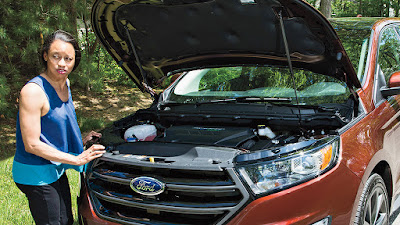Nothing’s worse than stepping into a boiling-hot car. Try these tips to cool down fast.
To Keep Yourself Cool...
Immediately turn on the AC.

It’s an age-old debate: Do you hit the AC as soon as you get into the car or wait until the engine gets going? The answer: Blast those suckers as soon as possible. But make sure you set the AC to fresh air (not recirculate, which draws heat from the interior) and adjust the air to come through the lower openings, not the upper ones; this will push the hot air out from the bottom. Then roll down the windows. Once the hot air has escaped, close the windows and open all the vents. For more on Ford climate controls, watch these videos for
Ford Escape/Focus/C-MAX,
Ford Fusion or
Ford Focus.
Park in the shade—
or make your own.

This may seem obvious, but parking your vehicle in a cool, sheltered area really can make the difference between whether you end up smiling or sizzling. Covering both the front and rear windows with a
high-quality sun shade while it’s parked can also greatly reduce the heat and protect your vehicle’s interior from harmful UV rays.
Crack open the windows while parked.

The hot air in your vehicle is essentially an abundance of energy, trapped with nowhere to go, like an oven. Leaving your windows open about a half-inch will allow some of the heat to escape—which will make a noticeable difference inside. You can purchase
side window deflectors that will help keep your car protected from vandals and the elements while allowing airflow.
Consider your loved ones before leaving the house.

Simple precautionary steps—such as dressing appropriately and packing cold drinks in a portable, secured cooler—can make long drives in high temperatures much more comfortable. Never leave children or pets alone in a parked car. When it’s 85 degrees outside, the temperature inside a vehicle can reach 102 degrees within 10 minutes, even with the windows cracked open, and can get up to 120 degrees within a half-hour. For the same reason, don’t leave any electronics in the car, unless you bought your gadget on Venus.
Throw in the towel.
Keep a towel in your car to give an extra layer of protection for bare legs on hot seats in the summertime. It can also come in handy as a cleanup rag whenever you need it.
To Help Your Car Beat the Heat...
Inspect your vehicle before high temperatures hit.

Just like the frigid cold, extreme heat can exacerbate problems all over your vehicle. It can cause your vehicle’s tires to deflate more rapidly, belts and hoses to crack and battery to drain. This means everything should be in top shape before the sweltering begins. Start by
checking your tire pressure. It’s important to do this only when your tires are “cold”—meaning the vehicle has been parked for at least one hour in the shade—or the reading won’t be accurate. Remove the tire valve cap and place the tire pressure gauge on it firmly. The number shown on the screen or dial (depending on whether the gauge is digital or analog) is your current tire pressure. Your vehicle’s operating inflation level is listed on the tire placard, which is often located on the doorjamb. If your tire’s pressure is low, use an air pump to add air. If it’s high, release air by pressing the tire valve stem. Then recheck. Once the tire is properly inflated, replace the valve cap.
Next, examine your battery for excess wear or corrosion, which can be caused by hot temperatures evaporating the battery fluid more quickly. Corrosion can take the form of rust, cracks in the battery’s body or a white powdery substance caused by chemical buildup. Cleaning a battery can be hazardous, so it’s best to get it looked at by a
Ford technician.
Heed your warning lights.

If your battery warning light—you know, the one that comes on momentarily when you turn the ignition—stays on, that means you could potentially have an alternator problem. Extreme heat and the heavy use of your air conditioner can be tough on your alternator, so if the warning light persists, have your vehicle checked at your local
Ford Dealer Service Center right away. (Find out the
five warning signs of a faulty alternator.)
Check the coolant.
It’s also crucial to make sure your vehicle’s coolant system is always properly filled. If it isn’t, the engine could overheat, causing your car to break down. Most new vehicles have a visible fill tank that you can open and check yourself. If your coolant is low, follow
these instructions on how to refill it.
Lose weight.

No, you’re not too fat—but if your vehicle is carrying a heavy load, it can be tough on your transmission, which is already stressed from the summer heat. Also don’t forget to change the transmission fluid and filter. Check your owner’s manual, available online at
owner.ford.com for the recommended maintenance schedule based on your vehicle’s model, make and year.
Protect your vehicle’s exterior and interior.
Constant, direct sun exposure can cause paint to crack and upholstery to fade. For the exterior, use sealant or wax—a good coat should protect your vehicle for the whole summer. For the interior, apply fabric protectant (but be sure to test it on a small area first) to help preserve its appearance. Now you’re ready to go out and enjoy a sunny drive.


















